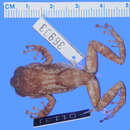Description
provided by AmphibiaWeb articles
This species measures in average 35 mm. It is dark dorsally, sometimes with an inverted parenthesis. It can also be identified because it has a constriction behind the head, short and rounded snout. Males have a dark throat (Rivero 1998) .
- Angulo, A. 2008. Eleutherodactylus hedricki. In: IUCN 2013. IUCN Red List of Threatened Species. Version 2013.1. www.iucnredlist.org. Downloaded on 24 July 2013.
- Rivero, J. A. (1963). ''Eleutherodactylus hedricki, a new species of frog from Puerto Rico (Salienta, Leptodactylidae).'' Breviora, 185, 1-7.
- author
- Luis J. Villanueva-Rivera
Distribution and Habitat
provided by AmphibiaWeb articles
This species is found in high elevation forests. It calls from and lays eggs in cavities in trees, (Rivero, 1963) so old trees can be a limiting factor in its distribution.
- author
- Luis J. Villanueva-Rivera
Life History, Abundance, Activity, and Special Behaviors
provided by AmphibiaWeb articles
The call is a series of loud pings, that sound like hitting an anvil (Rivero, 1998). It is not abundant where it is found, but no population has dissapeared recently (Villanueva-Rivera, pers obs).
- author
- Luis J. Villanueva-Rivera
Life History, Abundance, Activity, and Special Behaviors
provided by AmphibiaWeb articles
While the species can be found in many protected areas, the latest IUCN assessment states that chytridiomycosis is the leading cause of decline in this species. A call for ex-situ population development has been called for (Angulo 2008).
- author
- Luis J. Villanueva-Rivera

